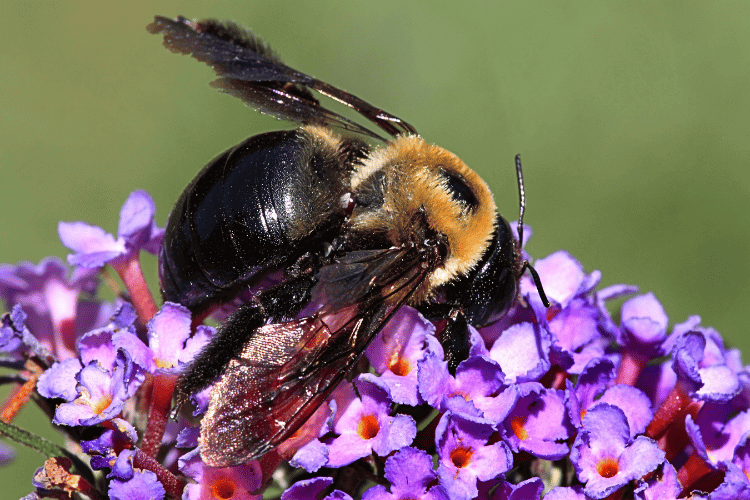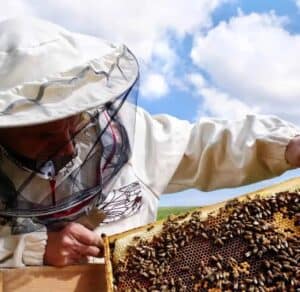Your Detailed Guide on Carpenter Bees
As an experienced beekeeper, I’ve had the pleasure of working with all sorts of bees, including carpenter bees. Today, I’ll take you through a closer look at them.
In this article, I’ll discuss their appearance, behavior, nesting habits, and how to deal with them if they become a problem. I’ll also share some tips on how to attract carpenter bees to your garden.
Eager to learn more about this fascinating species? Let’s not keep you waiting!
What Are Carpenter Bees?

Carpenter bees are large, solitary bees that are common in North America.
They aren’t aggressive and don’t sting unless provoked. However, they can cause damage to wood by excavating tunnels to nest in.
Appearance
Carpenter bees are about 1 inch long and have shiny, black abdomens.
They’re often mistaken for bumblebees, but bumblebees have hairy abdomens. Carpenter bees also have a distinctive “buzzing” sound when they fly.
Behavior
Carpenter bees are active during the day, especially in the spring and summer. They’re attracted to flowers, where they collect pollen and nectar to feed their young.
Additionally, carpenter bees prefer to nest in soft, dead wood. They excavate tunnels in the wood to create their nests, which can cause damage to the structure.
Nesting Habits
Female carpenter bees are the ones who create those wooden tunnel nests. They typically lay their eggs in these tunnels, along with a food supply of pollen and nectar.
The eggs hatch into larvae, which feed on the food supply until they’re mature. The mature larvae then pupate, and the adults emerge in the spring.
Impact on the Environment
Carpenter bees are important pollinators. They help to ensure that our crops and wildflowers reproduce.
Where Do Carpenter Bees Live?
From experience, I usually spot carpenter bees around the following areas:
- Wooden structures: Carpenter bees are often seen flying around wood siding, fence posts, and decks. This is because they prefer to nest in soft, dead wood.
- Dead trees: Dead trees are also attractive sites for these bees as they’re often seen excavating tunnels in the bark of dead trees.
- Hollowed-out logs: Carpenter bees might nest in hollowed-out logs too. They’re attracted to the soft, dead wood that’s found in these logs.
Other pro tips to help you spot carpenter bees include:
- Look for circular holes in wood: As mentioned, carpenter bees excavate circular holes in wood to create their nests. These holes are often visible on wooden structures.
- Search for piles of sawdust: Carpenter bees leave sawdust piles while making these holes. Keep an eye out for them near the nest entrance.
- Listen for that distinctive “buzzing” sound they make.
How Do Carpenter Bees Reproduce?
Carpenter bees are solitary insects, which means that each female bee mates with a single male bee and produces her own brood of offspring.
We’ve already gone through their nesting habits so here I’ll explain the steps involved in carpenter bee reproduction.

1. Mating
In the spring, male carpenter bees emerge from their nests and search for mates. Once a male finds a female, they’ll mate in midair.
2. Nesting
After mating, the female carpenter bee will excavate a tunnel in wood to create her nest. The tunnel is typically about 1 inch in diameter (about the diameter of a human finger) and 6 inches deep.
3. Laying Eggs
The female carpenter bee will lay her eggs in the nest, along with a food supply of pollen and nectar. The eggs hatch into larvae in about 2 weeks.
4. Larval Development
The larvae feed on the food supply for about 6 weeks. During this time, they’ll grow and molt several times.
5. Pupation
Once the larvae are mature, they’ll pupate. The pupal stage lasts about 2 weeks.
6. Adult Emergence
The adult carpenter bees will emerge from the nest in the spring.
Can Carpenter Bees Produce Honey?
No, carpenter bees don’t produce honey. Honey bees are the only type of bee that produces honey.
Carpenter bees are solitary bees, meaning that each female bee raises her own brood of young. They don’t live in colonies like honey bees, and they don’t have a need to store honey for food.
Additionally, carpenter bees eat nectar and pollen from flowers, but they don’t store this food for later use. Instead, they use the nectar and pollen to feed their young.
Honey bees, on the other hand, are social bees. The bees in a honey bee colony work together to collect nectar and pollen from flowers. They then store the nectar and pollen in honeycombs made of wax.
What Wood Types Do Carpenter Bees Like?
From what I’ve seen, carpenter bees prefer to nest in soft woods, weathered wood, seasoned wood, and dead wood, such as pine, cedar, and redwood. Nail holes seem appealing to them too.
On the other hand, they won’t nest in sound wood. Other woods, such as oak and Douglas fir, are also less attractive to carpenter bees. However, there’s no guarantee that any particular wood will be immune to them.
We already know that carpenter bees cause damage to wood, especially if they’re allowed to nest in the same area for several years. They’ll use their mouths to ‘peck’ their way through the wood grain and create sawdust piles in the process.
I’d like you to know that carpenter bees hardly compromise the structural integrity of anything. They’ll leave you with damaged wood, yes, but won’t cause any extensive damage.
Either way, you’ll find some of my tips on how to deal with carpenter bee damage or an infestation later on.
Carpenter Bees vs Honey Bees: A Detailed Comparison
As a beekeeper, you’re most likely to have dealt with honey bees more than carpenter bees.
It’d be interesting to compare the two—so, let’s take a look together.
Appearance
We’ve established that carpenter bees are large and black, with shiny abdomens. They’re about 1 to 1.5 inches long.
Meanwhile, honey bees are smaller than carpenter bees and have fuzzy, yellow-brown bodies. They’re about 0.5 to 0.75 inches long.

Behavior
Carpenter bees are solitary bees, so each female bee raises her own brood of young. They aren’t as aggressive as honey bees and are less likely to sting.
Honey bees, however, are social insects. They live in colonies of up to 60,000 bees. They’re more aggressive than carpenter bees and are more likely to sting if they feel threatened.
Nesting
While carpenter bees excavate tunnels in wood to create nests for their young, honey bees nest in hives, which are made up of hexagonal cells made of wax. They reuse the same hive year after year.
Diet
Both carpenter bees and honey bees eat nectar and pollen from flowers. However, carpenter bees also need protein to feed their young, so they’ll sometimes eat insects.
How Can I Prevent Carpenter Bees From Nesting in My Home?
While the bees won’t cause structural damage, the sight of coarse sawdust, entrance holes, and near-perfect circles scattered around isn’t great either.
That said, there are a few preventive measures you can take to coexist with them:
- Keep your wooden surfaces painted or stained. This will make the wood less attractive to carpenter bees. Make sure your wood is always dry and free of moisture too.
- Seal any cracks or holes in your siding or other wooden structures. It’ll prevent carpenter bees from getting inside.
- Install bee traps around your home. This way, you catch carpenter bees before they can nest.
- Plant trees and shrubs that attract bees away from your home. Also, remove any dead or dying trees since they’re attractive sites for these bees.
- Inspect your home and property regularly for signs of carpenter bees, such as sawdust piles or holes in the wood.
- Choose from a wide variety of hardwoods for construction projects instead of soft wood.
What if I Already Have Carpenter Bees Nesting in My Home?
If you already have a carpenter bee problem, you can take the following steps to get rid of them:
- Hire a professional pest control company to control the carpenter bee infestation.
- Drill a hole into the nest and fill it with expanding foam. This will suffocate the bees.
- Seal the nest opening with caulk or wood putty. It’ll prevent the bees from getting back in.
- Remove the nest and dispose of it properly.
Know this too:
While there are no federal laws against removing carpenter bees, some states and cities have laws that restrict or prohibit the use of certain pesticides to control carpenter bees.
Summary: Know Enough about Carpenter Bees Now?
Carpenter bees are big, black bees that aren’t as aggressive as you might think. They like to nest in soft, dead wood, but they won’t hurt you unless you bother them.
These bee species live alone, so you won’t find a whole nest of them. They mainly like to nest in places like your deck or siding. They can also damage wood over time, but it’s usually not too bad.
With my tips, you can help prevent carpenter bees from nesting in your home or property—though it’s best to have a professional do it and to consult the law before taking action.

Joseph Davis
My goal is to show that anyone can take up beekeeping and it can be a very rewarding hobby. I strive to share my experiences and answer any questions you may have.
